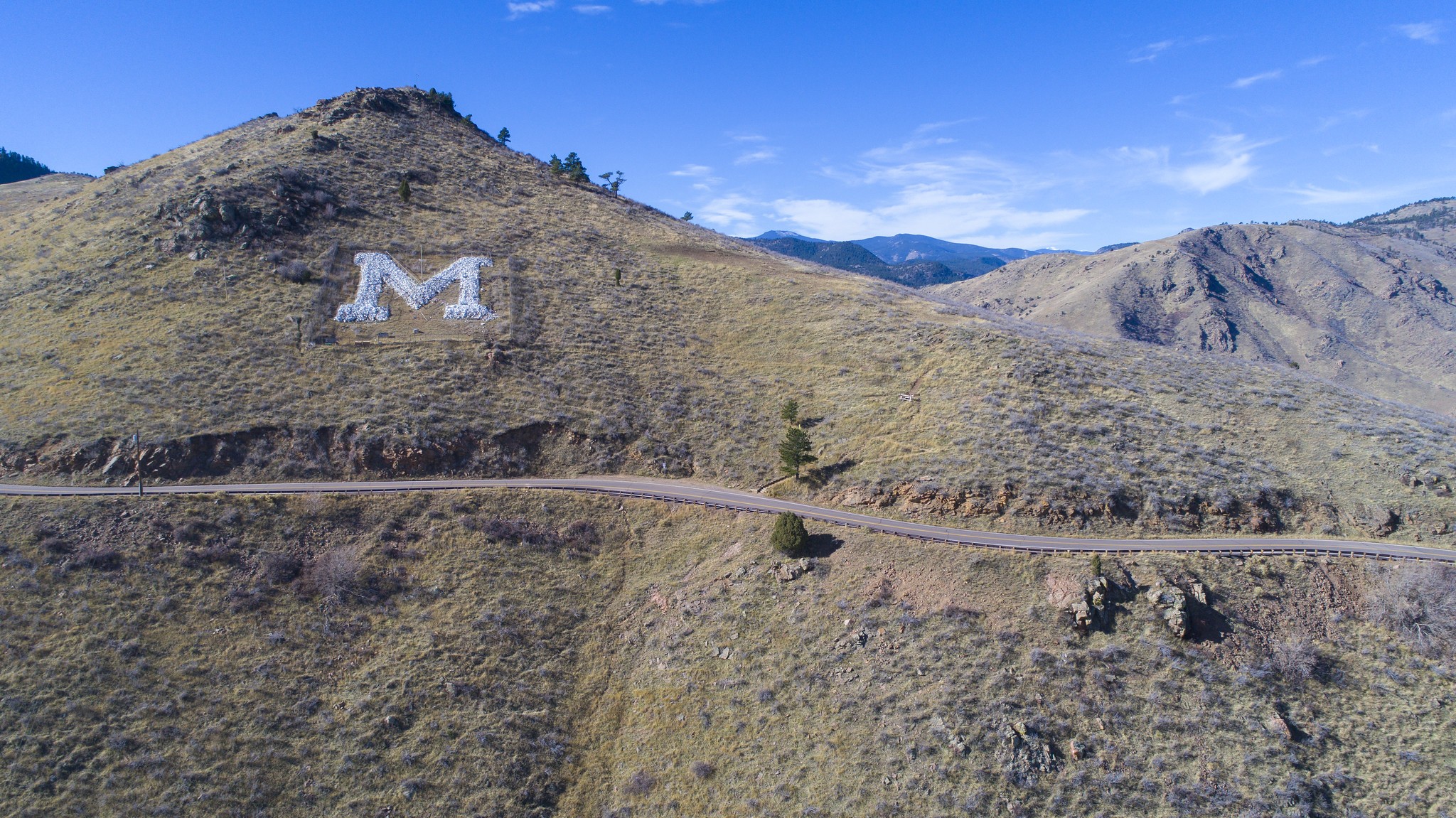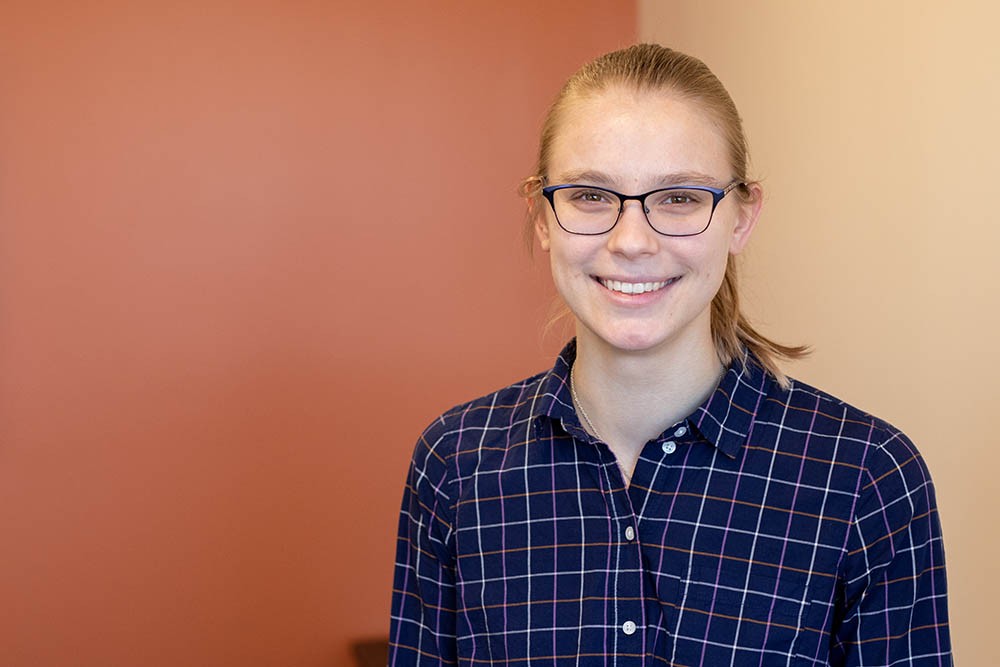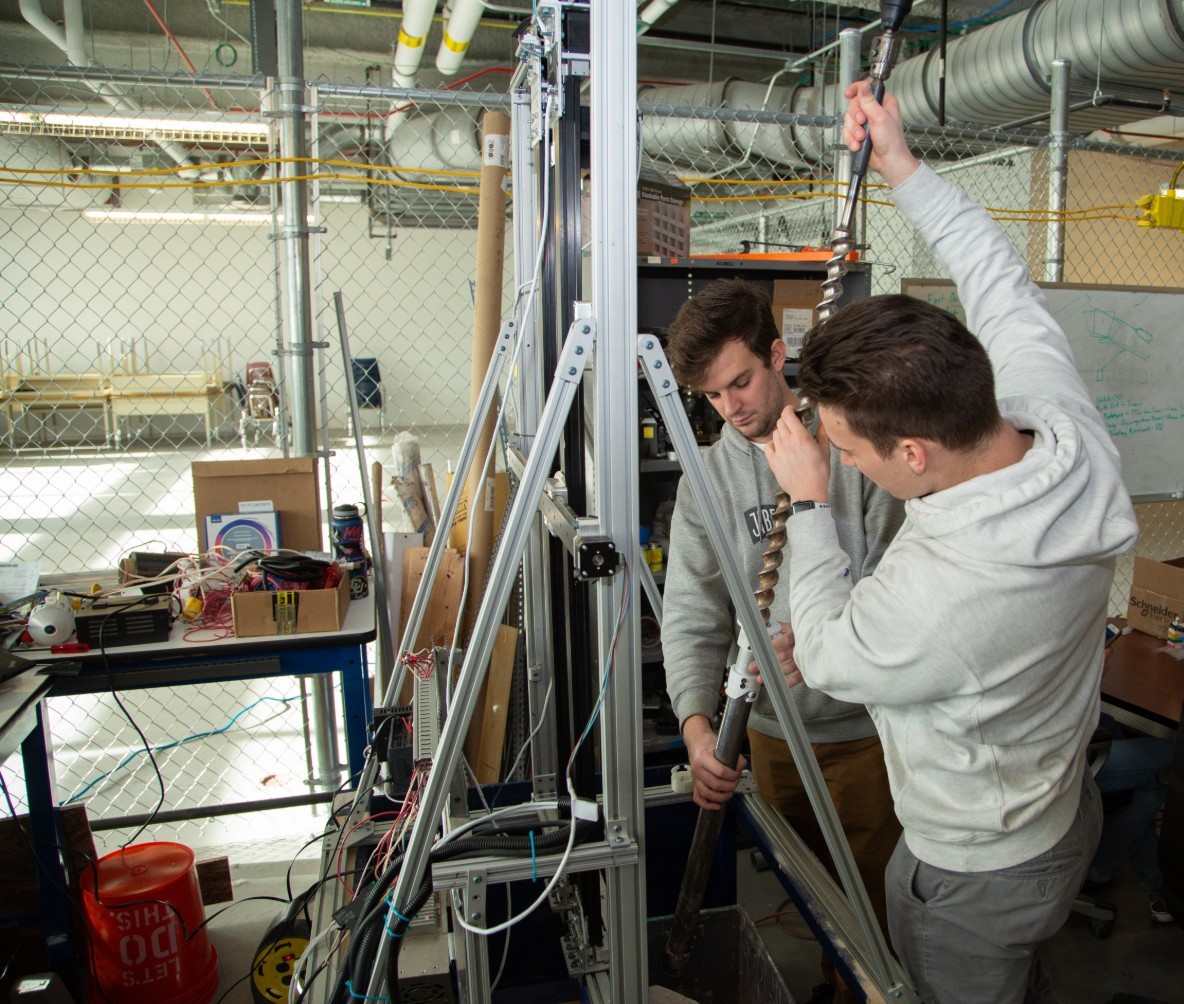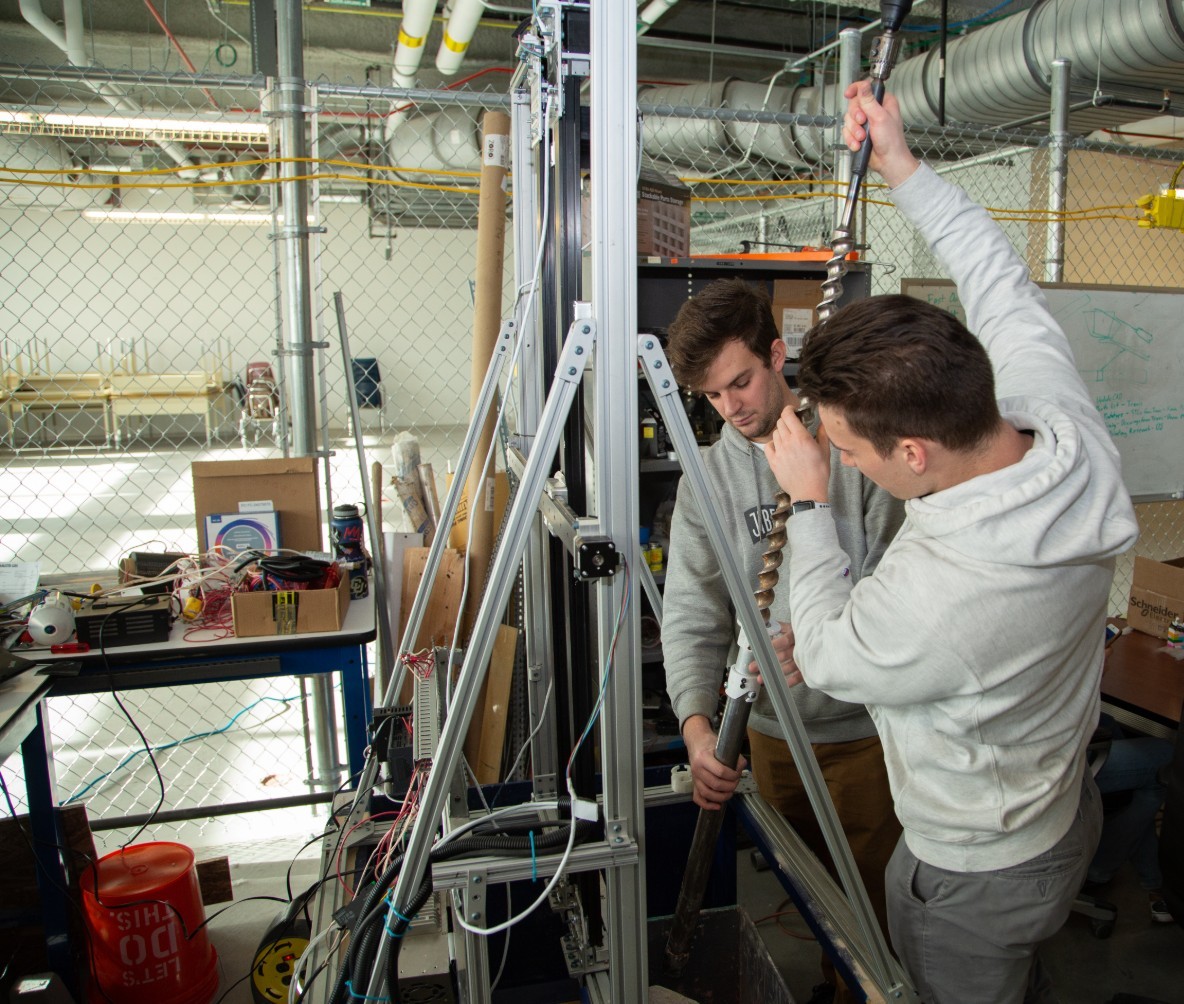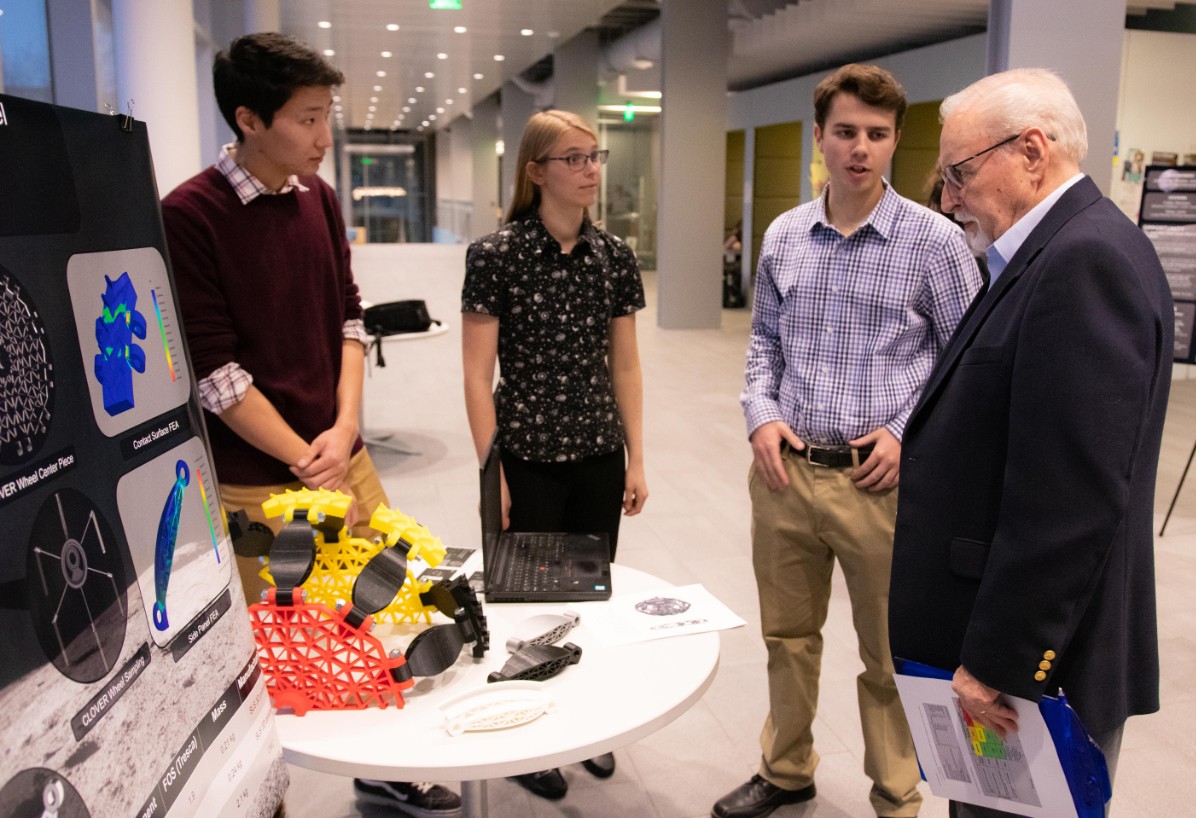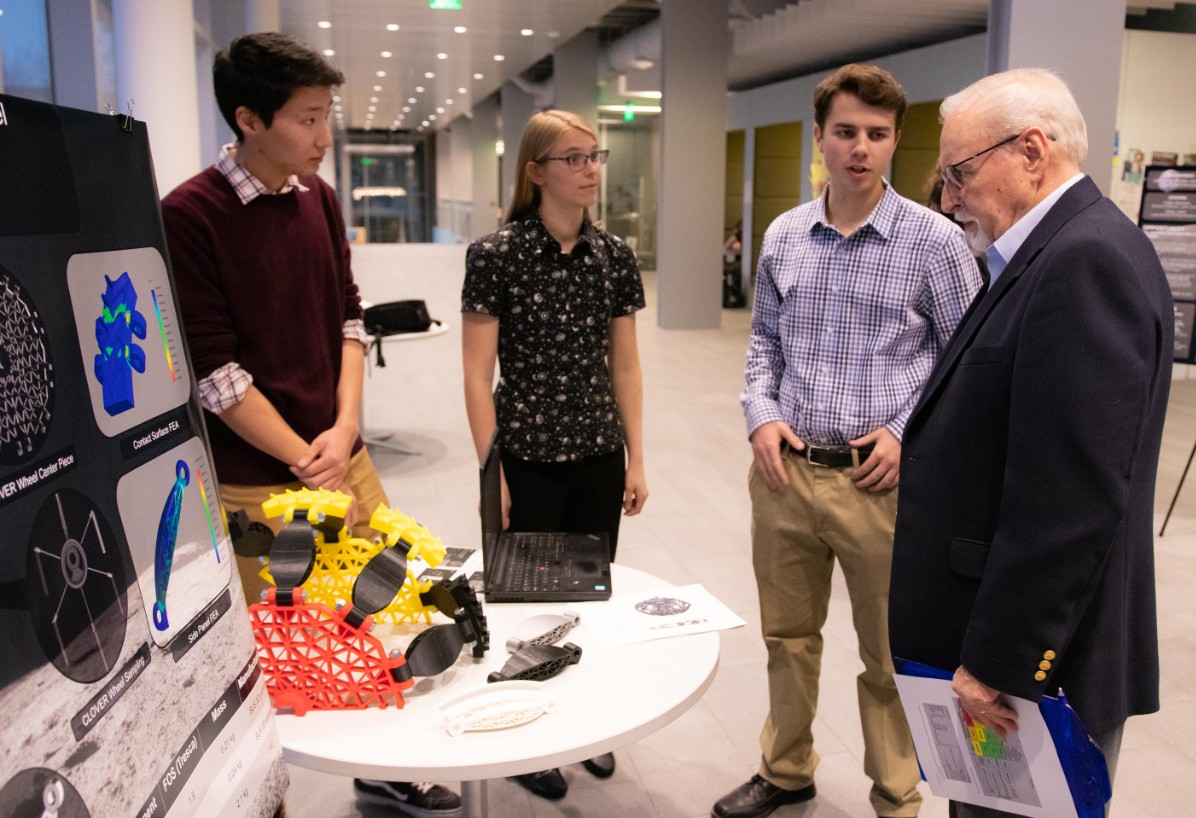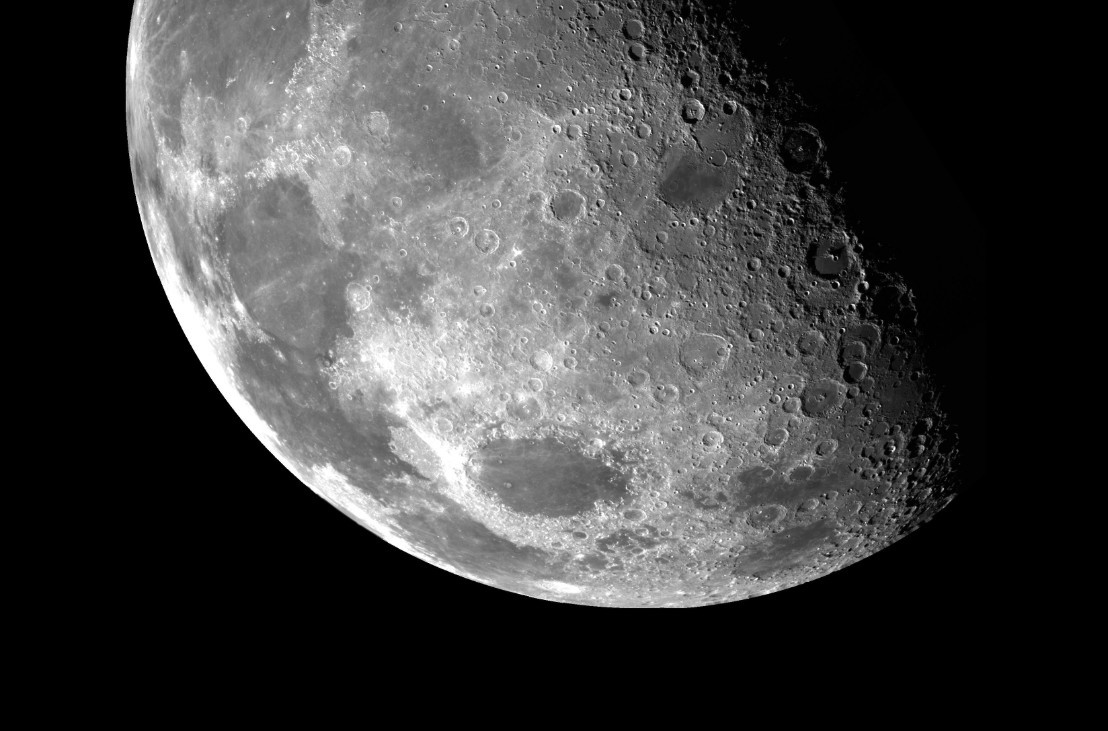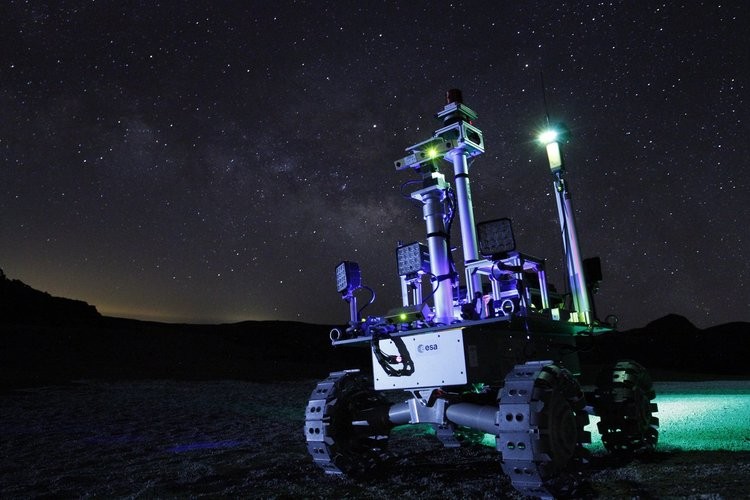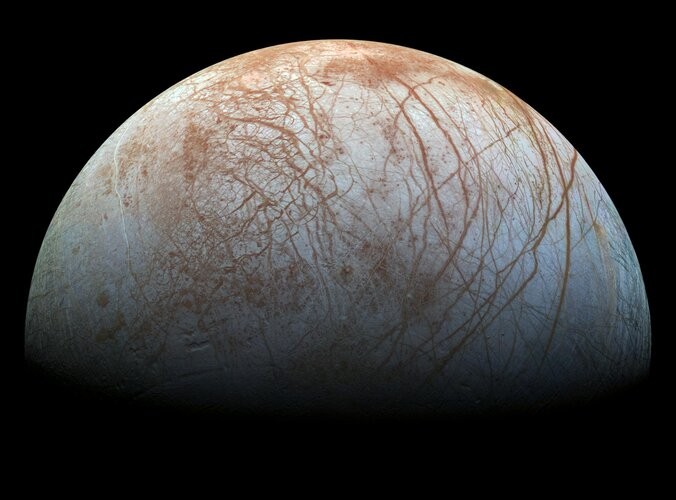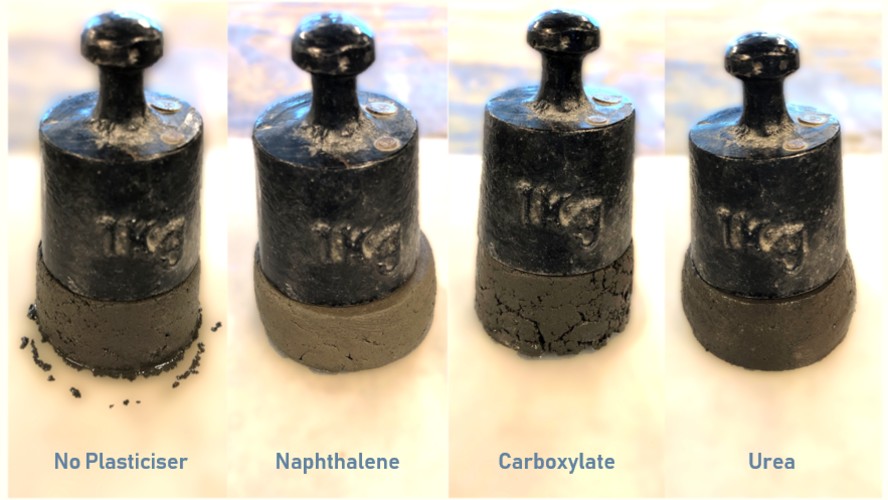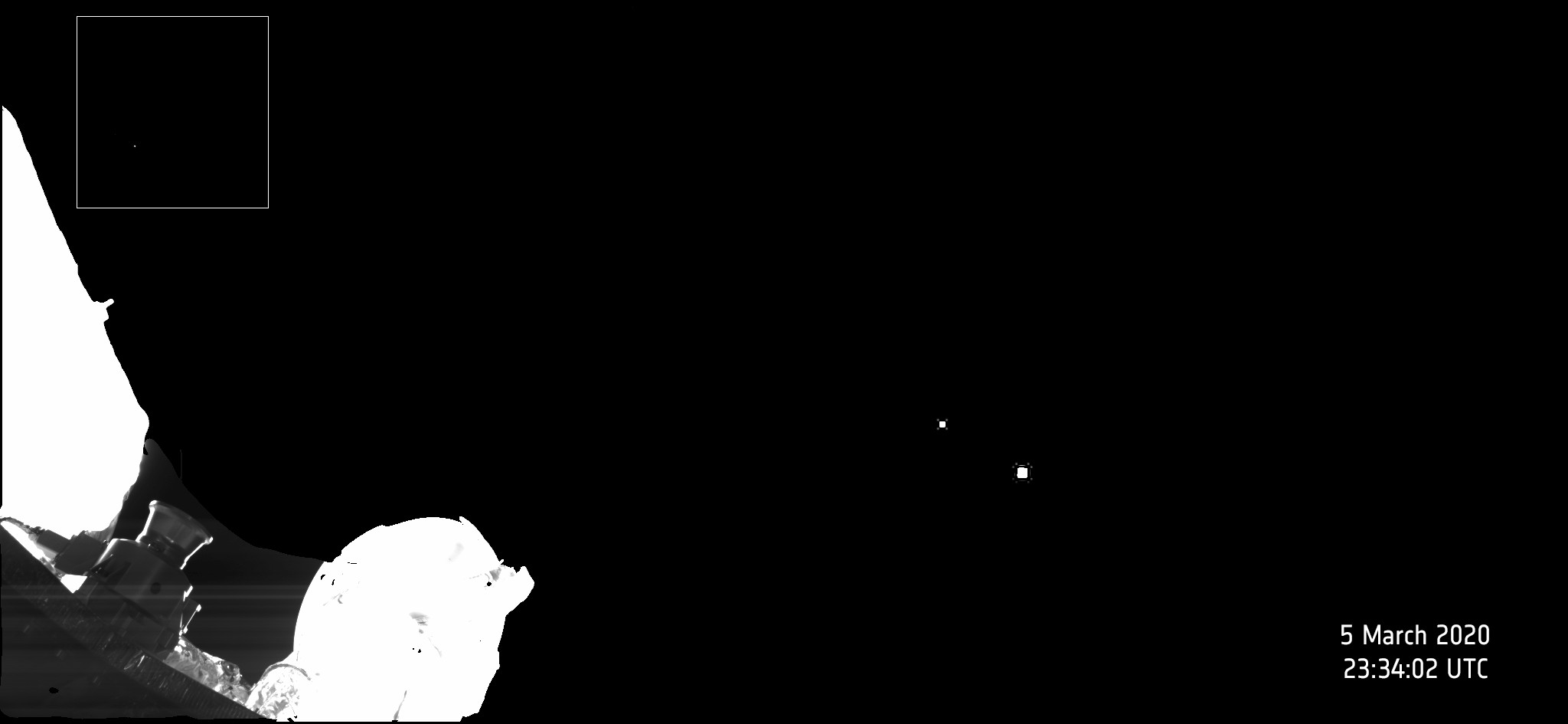Science
-
5 years ago
Keep climbing this summer: Register now for Summer I and II courses
MinesNewsRoomMines is offering nearly 90 courses this summer, many of which fulfill core course and major requirements. Pink planets, yellow moons, orange stars and green nebulas — learn about the “Lucky Charms of the Galaxy” and more this summer by registering now for Summer I and Summer II courses. Colorado School of Mines is offering nearly 90 courses over the Summer I and Summer II terms, many of which fulfill core course and major requirements. Some of our most popular courses and professors, as well as those best suited to online delivery, are being offered to Mines students. Summer I runs from May 11 through June 19. Summer II begins June 22 and ends July 31. Enrollment for the Summer I term is already up over last year. “I’m not surprised,” said Paul Myskiw, Mines’ registrar. “We’re hearing that students are intent on using this time to stay on track and even get ahead as we head into the new academic year.” Some of the courses available this summer include: Planetary Geology (GEOL410) with Lesli Wood (Summer I): This completely online course is an introduction to the geology of planets, moons, and other bodies within and beyond our solar system. The course will feature Zoom discussion sessions, guest lecturers in space resources and cool projects—perfect for anyone interested in space resources or planetary research, or in search of a cool elective. Introduction to Science Communication (HASS323) with Cortney Holles (Summer I): Have you ever struggled to communicate your work or your passions to friends and family? Do you get frustrated with arguments about science issues? This HASS 300-level elective course introduces key issues in science communication studies including historical and contemporary debates and current research that shapes our understanding of how people engage with science. The class allows you to practice translating technical information for the public audience, engaging in debates about controversial science issues and analyzing your audience to craft your message. Programming Concepts (CSCI261) with Jeffrey Paone (Summer I): This CS course is a prerequisite for many courses on campus and introduces fundamental computer programming concepts using a high-level language and a modern development environment. Programming skills include sequential, selection, and repetition control structures, functions, input and output, primitive data types, basic data structures including arrays and pointers, objects, and classes. Software engineering skills include problem solving, program design, and debugging practices. Introduction to Petroleum Industry (PEGN102) with Linda Battalora (Summer II): Did you know that mechanical engineers, chemical engineers, physicists, mathematicians, metallurgical engineers, environmental engineers, bioscientists and many other engineering and science disciplines are employed by the oil and gas industry? Have you ever wondered how oil and natural gas fit in the energy mix? This summer you can learn online about the upstream, midstream and downstream sectors of the oil and gas industry—no prerequisites. Introduction to Neuroscience (CBEN311) with Cynthia Norrgran (Summer II): This course, which fulfills requirements for biomedical engineering and biology minors, explores the world of the brain, its function and how scientists study it. How does the brain send signals? How do the senses work? How can we move muscles, think, learn, and make decisions? Learn all that and more in the online hybrid course. For the most complete, up-to-date list of summer courses, log into Trailhead and view the Dynamic Schedule for Summer 2020 or use the GEODE Schedule Planner.
Read More -
5 years ago
Keep climbing this summer: Register now for Summer I and II courses
MinesNewsRoomMines is offering nearly 90 courses this summer, many of which fulfill core course and major requirements. Pink planets, yellow moons, orange stars and green nebulas — learn about the “Lucky Charms of the Galaxy” and more this summer by registering now for Summer I and Summer II courses. Colorado School of Mines is offering nearly 90 courses over the Summer I and Summer II terms, many of which fulfill core course and major requirements. Some of our most popular courses and professors, as well as those best suited to online delivery, are being offered to Mines students. Summer I runs from May 11 through June 19. Summer II begins June 22 and ends July 31. Enrollment for the Summer I term is already up over last year. “I’m not surprised,” said Paul Myskiw, Mines’ registrar. “We’re hearing that students are intent on using this time to stay on track and even get ahead as we head into the new academic year.” Some of the courses available this summer include: Planetary Geology (GEOL410) with Lesli Wood (Summer I): This completely online course is an introduction to the geology of planets, moons, and other bodies within and beyond our solar system. The course will feature Zoom discussion sessions, guest lecturers in space resources and cool projects—perfect for anyone interested in space resources or planetary research, or in search of a cool elective. Introduction to Science Communication (HASS323) with Cortney Holles (Summer I): Have you ever struggled to communicate your work or your passions to friends and family? Do you get frustrated with arguments about science issues? This HASS 300-level elective course introduces key issues in science communication studies including historical and contemporary debates and current research that shapes our understanding of how people engage with science. The class allows you to practice translating technical information for the public audience, engaging in debates about controversial science issues and analyzing your audience to craft your message. Programming Concepts (CSCI261) with Jeffrey Paone (Summer I): This CS course is a prerequisite for many courses on campus and introduces fundamental computer programming concepts using a high-level language and a modern development environment. Programming skills include sequential, selection, and repetition control structures, functions, input and output, primitive data types, basic data structures including arrays and pointers, objects, and classes. Software engineering skills include problem solving, program design, and debugging practices. Introduction to Petroleum Industry (PEGN102) with Linda Battalora (Summer II): Did you know that mechanical engineers, chemical engineers, physicists, mathematicians, metallurgical engineers, environmental engineers, bioscientists and many other engineering and science disciplines are employed by the oil and gas industry? Have you ever wondered how oil and natural gas fit in the energy mix? This summer you can learn online about the upstream, midstream and downstream sectors of the oil and gas industry—no prerequisites. Introduction to Neuroscience (CBEN311) with Cynthia Norrgran (Summer II): This course, which fulfills requirements for biomedical engineering and biology minors, explores the world of the brain, its function and how scientists study it. How does the brain send signals? How do the senses work? How can we move muscles, think, learn, and make decisions? Learn all that and more in the online hybrid course. For the most complete, up-to-date list of summer courses, log into Trailhead and view the Dynamic Schedule for Summer 2020 or use the GEODE Schedule Planner.
Read More -
5 years ago
Center for Underground to design, demonstrate rapid tunneling technology
MinesNewsRoom<p>The <a href="https://underground.mines.edu/">Center for Underground</a> at Colorado School of Mines recently was awarded a major contract from the U.S. Defense Advanced Research Projects Agency (DARPA) to design and demonstrate rapid tunneling technology.</p> The Center for Underground at Colorado School of Mines recently was awarded a major contract from the U.S. Defense Advanced Research Projects Agency (DARPA) to design and demonstrate rapid tunneling technology. “This project should dramatically improve tunneling efficiency,” said Mike Mooney, Grewcock Distinguished Chair of Underground Construction and Tunneling and the project’s director and lead investigator. “Our proposed advances aim to drive down the cost of tunneling and dramatically increase the speed of tunneling over current practice." The project is highly interdisciplinary, blending the civil tunneling and horizontal directional drilling expertise at Mines with petroleum drilling engineering, chemical engineering, mechanical engineering and geophysics expertise. "This project brings together all the right expertise to advance rapid tunnel construction,” said Bill Eustes, associate professor of petroleum engineering. “Our approach blends horizontal directional drilling’s operational framework and oil and gas directional drilling’s proven metric-exceeding speed and distance performance with additional advances in excavation mechanics, tunnel installation, ground imaging and artificial intelligence,” Mooney said. “This unique project provides an opportunity for step change advances in tunneling technology that can improve tunnel construction for water, wastewater, transportation and utilities. The R&D effort is structured as a university-industry innovation incubator at Mines. The Center for Underground brought in full-time engineering professionals with expertise in sensing, artificial intelligence, mechanical systems, smart fluids and instrumentation to work closely with Mines faculty experts. “We are organized as a university-industry melting pot of different disciplines, skill sets and perspectives, with innovative ideas flying all over the place,” said Joseph Samaniuk, assistant professor of chemical and biological engineering. Mines will also bring in partners in field testing. The research team plans a field site demonstration targeting sustained tunneling advance rates of 1200 feet per hour fifteen months from now. The project will be described during the Tunneling Fundamentals, Applications and Innovations industry short course held at Colorado School of Mines October 19-22, 2020. More information can be found at underground.mines.edu.
Read More -
5 years ago
Need the perfect elective to round out your Fall/Summer 2020 schedule? Look no further.
MinesNewsRoom<p>Registration is underway for the Summer and Fall 2020 semesters at Colorado School of Mines. Below you’ll find some of the new and interesting courses being offered for all students.</p> Registration is underway for the Summer and Fall 2020 semesters at Colorado School of Mines. Below you’ll find some of the new and interesting courses being offered for all students. Fall 2020 Course Offerings Introduction to Space Exploration (MEGN 408): All systems are GO. Launch Day is Monday, August 24 at 6 p.m. in CTLM 102 for all of you space enthusiasts, regardless of department, major or class standing. Come aboard for this semester-long space ride. Learn more about the course here. Anatomy and Physiology (CBEN 304): Ever wonder what structures make up the human body? Interested in learning more about how the human body (and other animals) works? Curious about how you can apply engineering principles to the human body? If so, CBEN 304 is for you. Monday/Wednesday/Friday from 1 to 1:50 p.m. Chemistry and Biochemistry of Pharmaceuticals (CHGN 441): With new diseases and illicit drugs popping up around the world on a nearly daily basis, this course will explore the chemistry and biochemistry of drugs used to fight these diseases and recreational drugs. This course covers what drugs do to the body, side effects, testing and forensic detection. Offered Monday/Wednesday/Friday at 2 p.m. Fundamentals of Catalysis (CHGN 584): For every $10 million invested into catalysis, it returns $10 billion. Earth would be 1/3-1/2 as populated without the development of the Haber-Bosch process to synthesize ammonia from molecular nitrogen and hydrogen for fertilizer. This course discusses historically important developments in catalysis, along with new developments. Characterization of catalytic materials are covered, as well. Offered Tuesday/Thursday at 8 a.m. Educational Psychology and Assessment (SYGN 398): An explosive growth in research on how people learn has revealed many ways to improve teaching and catalyze learning at all ages. The purpose of this course is to present this new science of learning so that educators can creatively translate the science into exceptional practice and know if they succeed. This course is designed to prepare students for college or high school teaching. 3 credits. Tuesday 6:30 to 7:15 p.m. K-12 Field Experience (SYGN 498): This course is the ideal way to try out teaching. Assist in a classroom alongside an experienced mentor teacher. Requirements include a total of 25 hours in the classroom and a 50-minute weekly seminar. Repeatable. Classroom hours are work study eligible. Thursday 6:30 to 7:20 p.m. Get more information about the course here. Introduction to Nuclear Engineering (ENGY498A/MEGN498C): Discover the wonder that is nuclear engineering! This course will provide a general primer for nuclear engineering principles and serve as a useful gateway to those considering a 4+1 MS degree. The basics of nuclear engineering will be discussed in the context of nuclear security and the nuclear fuel cycle. Tuesday/Thursday 11 a.m. to 12:15 p.m. Communities and Natural Resource Development (MNGN 335): Even though this course has a mining prefix, students from all majors are welcome, and the course counts towards your H&SS required credits at Mines. We will go beyond case studies of mining and examine energy and other natural resource developments to understand the intersections between these developments, communities and the environment. Through project-based learning, students will gain the ability to assess development projects and the ways in which they engage communities and address their environmental impacts. Tuesday/Thursday 9:30 to 10:45 a.m. French 3: Culture and Conversation (LIFL 198A): Don't let your French skills get rusty! Set yourself apart by being able to converse in French and expand your knowledge of the francophone world. This course will focus on developing speaking and reading skills in a supportive and fun environment. Contact Madame Diercks at mdiercks@mines.edu for more info. Monday/Wednesday/Friday 10 a.m. Sustainable Development and Earth Resources (MNGN 567): Earth resource industries are increasingly being called on to contribute to sustainable development in the communities and regions in which they operate. In this graduate-level course, students will develop an understanding and appreciation of the ways in which resource extraction projects can contribute to sustainable development. The course is framed around the UN Sustainable Development Goals and includes an innovative format where we videoconference with faculty and students at Virginia Tech and Universidad Nacional de Colombia. Students interact and collaborate with others across disciplines, geographies and cultures. Tuesday 12 to 2:50 p.m. Engineering for Social and Environmental Responsibility (EDNS 315): Interested in becoming a more socially and environmentally responsible engineer? Want to wrestle with topics such as disaster prep, bioengineering and self-driving cars while earning H&SS 300-level credit at the same time? Sign up for EDNS 315! Monday/Wednesday 3 to 4:15 p.m. Numerical Methods for Engineers (CEEN405/505): This course combines theory with practical programming experience, in which all students will be given a powerful suite of pre-written programs for solving a wide range of engineering problems. Monday/Wednesday 3 to 4:15 p.m. Introduction to Nuclear Materials/Nuclear Materials Science and Engineering (MTGN 498A/593): Ever since the discovery of fission in 1938, nuclear energy has held the promise of nearly limitless, carbon-free power. While the basic theory of nuclear fission is well understood, developing materials that can withstand the unique conditions inside a nuclear reactor is still a significant challenge. This course will provide an overview of the physics and technology of nuclear reactors, a review of selected materials science concepts, a study of radiation effects on materials and a survey of nuclear materials selection and selection. The course will also cover the unique hazards posed by nuclear materials and challenges posed by the storage and disposal of radioactive materials. Tuesday/Thursday 9:30 to 10:45 a.m. Bioinorganic Chemistry (CHGN 498/598): Join us for an exploration of metals in biology! We'll discuss the many important roles of metals in biological processes as well as how to characterize metallo-biomolecules with spectroscopy and crystallography. We may also explore some special topics, such as metals in medicine, biomineralization and metals in the environment. Monday/Wednesday/Friday 12 to 12:50 p.m. Research Skills for Graduate Students (SYGN501): This 1-credit course helps graduate students develop effective research skills. Topics include choosing a research project, making a work plan, working with your advisor, goal setting, publishing papers, oral communication, writing proposals, time management, the scientific career and applying for a job. The class is also open to undergraduate students with an interest in research. Learn more about the course here. Thursday 2 to 3 p.m. Property Rights and Natural Resources (EBGN 434): Using the history of North American resource development and use, this course draws upon economics, history and law to understand how societies determine who gets to make decisions regarding resource use, what constraints they face and, ultimately, how these decisions impact the economy. The legal and economic property rights framework can readily help explain investment and development trends in land, water, oil and gas, wind and even development of space resources. Monday/Wednesday/Friday 1 to 1:50 p.m. Corporate Social Responsibility (EDNS 430): Corporations are everywhere around us and are some of the most powerful actors in our world. They can be praised for creating wealth and jobs, criticized for not accounting for public or environmental wellbeing in their pursuit of profit, and more. How do calls for greater accountability among corporations affect the engineers who work for them? What opportunities and challenges exist for engineers to better align profit, people, and planet through their work in the private sphere? This course, which fulfills an upper-division H&SS requirement, explores these questions and more through studying a wide variety of cases, from big data and telecommunications to solar energy and mining. Tuesday/Thursday 2 to 3:15 p.m. Engineers Engaging Communities (EDNS 479): We often talk about how engineering and applied science serve society. However, actually interacting with communities as a professional is by no means easy. Take this course to learn concrete skills and concepts necessary for respectful, meaningful community engagement. This course counts as 400-level HASS credit, an Area 1 elective for ECD minors and a required course for LSR minors. Tuesday/Thursday 11 a.m. to 12:15 p.m. Leading and Managing High-Performing Teams (EBGN 577): Effective leaders contribute significantly to their organization’s performance. This course is about developing your unique leadership skills and style whether you lead a small engineering team or, eventually, a large global corporation. Ultimately, you have to learn how to lead and motivate individuals who don’t look or think like you. Our learning-by-doing approach complements class discussions and case studies with a hands-on simulation of a leadership team facing a series of crises. Monday/Wednesday 2 to 3:15 p.m. Learn more about the class. Introduction to Business (EBGN 298): Mines graduates typically start their careers as engineers but quickly get tapped to manage and lead thriving businesses. In this interactive class, we cover what gives a business its competitive advantage, how businesses report information to investors and other general business concepts. We explore best practices including making sound decisions and communicating and how these concepts apply to your own career. This class is a perfect springboard for learning about economics and business processes. Monday/Wednesday/Friday 9 to 9:50 a.m. Intro to Computer Science- LAB (CSCI 102): Have you thought about learning how to program? If yes, this Python LAB course is for you! It’s only one credit and is very hands on. In today's world, ALL Mines students should learn how to code! Tuesday/Thursday at 9:30 a.m., 11 a.m. or 3:30 p.m. Learn more about the course. Quantitative Human Biology (CBEN413): Interested in a biology course that is math based? Quantitative Human Biology examines the heart, lungs, brain and muscles in a mathematical way. We will cover the transmission of signals in the brain, the pumping action and pressures of the heart and vascular system, the way muscles produce power and movement and the forces and pressures involved in breathing. It is a fun and interesting course that fulfills a requirement for both the biology minor and BME minor. Tuesday/Thursday 9:30 to 10:45 a.m. Professional Oral Communication (LICM 501): At Mines, we are engaged in practical disciplines of the earth, energy and environment. And yet sometimes, this hard and important work can get lost in translation as we switch between different audiences. This course provides you with the space to craft your own speaking style, refine your capacity to organize complex information, and ultimately make a memorable impact on people who might be transformed by you and your work. Monday/Wednesday 2 to 3:15 p.m. Arabic (LIFL 114): Arabic is the fifth most spoken language in the world. Skill in the language will improve employment opportunities in energy-producing areas of the Arab world and with certain branches of government. Learning the language is the keystone in understanding the culture, traditions, politics, geography and history of the Arab World from Morocco to Emirates and more. Counts toward mid-level H&SS credit. Tuesday/Thursday 5 to 6:15 p.m. Laser Physics (PHGN 480): Curious about how lasers work? Want to build one and learn how to use them? This is a course that will lead you from basic principles in optics, EM, and quantum mechanics to the design and hands-on building of real laser systems. We start with the interaction of light with atoms and molecules to see where optical gain comes from, then learn how laser beams propagate in free space and in resonators. You'll also learn how lasers can put out pulses that are useful for nonlinear effects and materials processing. Pair this with the new online summer Elements of Modern Optics course (PHGN498) to give the best background for non-majors. Monday/Wednesday 11 to 11:50 a.m. Thursday 9 to 11:50 a.m. (lab) Learn more about the course. Engineering Your Career Path (CSM 250): Professional career development is integral to the success of Mines graduates and to the mission of Mines. This 1.0 credit course is designed to provide the student with advanced career planning and job searching tools that are instrumental to be successful in obtaining internships, co-ops, research and full-time positions. The class will also give you guidelines on transitioning into a new career and making a positive impact in your chosen profession. In addition to working directly with you on skills and materials, we have top guest speakers lined up who are leaders in their respective industries to provide valuable advice and tips. Three sections offered: Tuesday/Thursday 1 to 1:50 p.m., Wednesday 2 to 3:15 p.m., Friday 9 to 10:15 a.m. Engineering Economics (EBGN321): As The Notorious B.I.G. so aptly stated, “Mo Money, Mo Problems.” In this class, you will learn how businesses make decisions to generate more money and limit, or even eliminate, more problems. The concepts taught in this class are useful in business and are extremely applicable in your personal life, as well. Learn where to invest, how to make an Authorization for Expenditure (AFE) and how to build uncertainty and risk into your decision making. Monday/Wednesday 3:30 to 4:45 p.m. History of Epidemics (HASS 498A & 498C): This class explores how epidemics and pandemics shaped human society, culture and politics, from the Plague of Athens in 430 BCE to the HIV/AIDS crisis in the 1980s. Studying diseases like the bubonic plague, smallpox, cholera, typhoid, tuberculosis, the Spanish Flu and polio, students will learn about how disease outbreaks contributed to the collapse of governments, determined the outcome of wars, threw people's deepest beliefs about religion and morality into question, and transformed relationships between states and their citizens. We will also examine how each of these epidemics changed how physicians understood the causes of disease, and in doing so, advanced medical knowledge. Tuesday/Thursday 2 to 3:15 p.m. or 3:30 to 4:45 p.m. Life Cycle Assessment (CEEN 401/501): Have you ever wondered what is more sustainable: paper vs. plastic, hybrid vs. electric vehicles, mining on Earth or the Moon? Students will learn to conduct a life cycle assessment (LCA) during a semester-long project of their choosing. The class has projects designed for all majors: rockets, renewable energy, tiny homes, clean water, advanced manufacturing and more. This 3-credit class can serve as a tech elective for any major and is only 8 weeks and fully online. Payne Scholars Program - Independent Study (HRNS 399 or EBGN 399): The top writers in the class will receive a paid internship with the Payne Institute the following summer. Meeting times vary based on Payne lecture series. Learn more about the program here. Summer 2020 Course Offerings Lean Manufacturing (AMFG 422/522): Learn about creating efficiencies in the manufacturing process. These skill sets can be applied to any process, from manufacturing in aerospace or automotive, to applying these skills to your everyday life. Students will benefit from learning these skill sets no matter what their focused field is. Online June 22 through Aug. 13. Learn more about the course here. Advanced FEA Theory & Practice (FEGN 525): This course offers the perfect balance of theory and hands-on software use to deliver a strong foundation in fundamental finite element analysis knowledge. From this beginning, students can go on to master any commercial FEA program and demonstrate expertise on the job. Asynchronous instruction. Learn more about the course here. Planetary Geology (GE 410): Planetary geology in the comfort of your own home. Join online and explore the planets for three semester hours. Learn more about the course here. Geological Fluid Mechanics (GEGN 351): Darcy, Coriolis and Bernoulli, oh my! In Geological Fluid Mechanics, you will be introduced to the physical processes that govern the movement of fluids in environmental and engineered systems. Theory meets application in this course, as students learn various approaches to solving idealized and real-world fluid mechanics problems. Asynchronous online. Learn more about the course here. Earth and Environmental Systems (GEGN 101): Getting GEGN 101 done over the summer gets you more personalized attention and a 4 SH distributed core course out of the way. Monday/Tuesday/Wednesday/Thursday 10 a.m. to 12:10 p.m. Personal Finance (EBGN304): Interested in learning how to get your financial life on the right track? In Personal Finance we cover topics such as budgeting and planning, developing and maintaining credit, the basics of investing, saving for retirement, buying/leasing housing and transportation, insuring your assets and evaluating job offers and employee benefits. Past students say this class was the best investment they ever made in themselves. The class is very hands on and you will walk away with a blueprint for your financial future. As a Summer 1 course, the class will be offered remotely with some flexibility in meeting time. The class counts towards the economics minor, the business and entrepreneurship minor and as a free elective. Email Professor Lafrancois for more information. Monday/Wednesday/Friday 8:45 to 11:15 a.m. Introduction to Petroleum Industry (PEGN 102): Did you know that mechanical engineers, chemical engineers, physicists, mathematicians, metallurgical engineers, environmental engineers, bioscientists and many other engineering and science disciplines are employed by the oil and gas industry? Have you ever wondered how oil and natural gas fit in the energy mix? This summer you can learn online about the upstream, midstream and downstream sectors of the oil and gas industry. Enroll in this three-credit-hour-course, with no prerequisites. Introduction to Neuroscience and Biological Psychology (CBEN311 and CBEN322): Want to take an online course over the summer to learn about the brain or the mind? There are two new online courses this summer. In CBEN311, Introduction to Neuroscience, you will learn how the brain works, how it sends signals, how the senses work, how we can move muscles, think, learn and make decisions. In CBEN322, Biological Psychology, you will learn how the mind works, how we think, our personalities, our motives and what happens in psychopathy and sociopathy and how it is treated. Both courses work for the biology minor and BME minor. Introduction to Additive Manufacturing (AMFG 401/501): Interested in 3D printing? Come learn about how to apply 3D printing in the manufacturing process flow. In this course we cover the seven standard classifications of additive technology along with pre and post processing techniques for additively manufactured parts. We also will discuss high-level aspects of materials and design for additive techniques and wrap it all around the economics of AM compared to standard fabrication techniques. Elements of Modern Optics (PHGN 498): Are you interested in optics? This introductory course is designed to prepare students for a variety of goals including enrollment in advanced optics courses and research in both academia and industry. Topics covered in the course will provide foundational skills vital to all areas of optics. Online. Zoom Office Hours, Monday/Wednesday/Saturday 9 to 11 a.m. Introduction to Science Communication (HASS 323): Have you ever struggled to explain your coursework or your interests to peers and family outside of Mines? Do you wonder why there is such controversy around engineering and science issues? Science Communication gives you the opportunity to learn techniques for communicating with a public audience in different formats and to explore controversies and miscommunications about science issues and debates. Tuesday/Thursday 3 to 6:15 p.m. Want to see your Fall/Summer 2020 course featured here? Fill out this form, and the Mines Communication team will add it to our next round-up in Today at Mines.
Read More -
5 years ago
Mechanical engineering student earns aerospace fellowship
MinesNewsRoomClaire Thomas, one of 40 members of the Brooke Owens Fellowship Class of 2020, will spend 10 weeks working at Made in Space, a company developing manufacturing technology for space, and receive mentorship from aerospace industry veterans. A Colorado School of Mines mechanical engineering major has been awarded a prestigious fellowship that provides undergraduate women and gender-minority students with paid aerospace internships and executive-level mentors. Claire Thomas, one of 40 members of the Brooke Owens Fellowship Class of 2020, will spend 10 weeks in Jacksonville, Florida, working at Made in Space, a company developing manufacturing technology for space. It’s a great fit for Thomas, who’s interested in in-situ resource utilization, the establishment of a lunar economy and long-term human space flight, and plans to pursue a master’s degree in space resources at Mines. “Made in Space has payloads exploring 3D printing on the International Space Station, such as one that can print a boom in space,” she said. “I’m also interested in the mechanics of materials and how they work in microgravity.” It won’t be Thomas’ first stint in industry—she’s finishing up a co-op this semester with Sierra Nevada Corporation in Wisconsin, where she’s been working on internal research and development. The company’s smaller projects include growing plants on the International Space Station and inflatable human habitats. This summer, Thomas will be paired with two senior mentors—one at her host company and another elsewhere in the industry. The pool includes astronauts, CEOs, journalists and government officials. “It could be anyone,” Thomas said, “along with the entire group of previous fellows who are already doing some really awesome things.” All 40 Brooke Owens fellows will also gather for a three-day summit in Washington, D.C., that will include team projects, mentoring sessions and private Q&A sessions with industry leaders. “It’s going to be a pretty hectic time, but it will be really cool networking and meeting new people and seeing the latest developments in aerospace,” Thomas said. “I’ve always wanted to do things people told me I couldn’t do,” Thomas said, explaining her motivation for pursuing engineering and aerospace. She had few mentors in science in high school—or even women teachers—so she hopes to be an advocate as she advances her own career. “At Mines, the president of American Institute of Aeronautics and Astronautics chapter is female, so that’s a really cool thing,” Thomas said. “I’m lucky to have female leadership at Mines—it shows you the possibilities, seeing someone super successful who’s like you, and helps with navigating things that people generally don’t talk about when interviewing, applying for jobs.” The Brooke Owens Fellowship was created in 2017 in honor of Dawn Brooke Owens, a pilot and space policy expert who worked with NASA, the Federal Aviation Administration and the White House. Its founders were three close friends of Owens who hold senior positions in the aerospace industry. Fellows are chosen based on their talent, experience, commitment to service and creativity.
Read More -
5 years ago
Mines students qualify for 2020 NASA Moon to Mars Ice & Prospecting Challenge
MinesNewsRoomTeam DREAMR – short for Drilling Rig for the Exploration and Acquisition of Martian Resources – is the fourth Mines team in four years to qualify for the one-of-a-kind collegiate aerospace competition. Students from Colorado School of Mines are headed to NASA’s Langley Research Center this summer for a competition that is out of this world. Who can extract the most water from a simulated slice of the Martian or lunar surface? The 2020 NASA RASC-AL Special Edition: Moon to Mars Ice & Prospecting Challenge will pit 10 university teams from across the nation in an on-site competition June 1-4 to find out. Team DREAMR – short for Drilling Rig for the Exploration and Acquisition of Martian Resources – is the fourth Mines team in four years to qualify for the one-of-a-kind collegiate aerospace competition. “Extracting water from deep space environments, it’s one of the biggest challenges we’re facing looking into the future. Anything we can do to contribute is really important,” said Tyler Baack, a senior majoring in mechanical engineering. “NASA is looking for original ideas.” The team's name, DREAMR, is short for Drilling Rig for the Exploration and Acquisition of Martian Resources .The all-mechanical engineering team has wasted no time in getting started remaking last year’s Mines rig into their own – the team stripped out and replaced all the electrical and control systems over winter break shortly after learning they qualified for the finals. “Our focus this year is on automation,” Baack said. “The system is going to need to be able to make decisions on its own. In deep space environments, we can’t have an operator. Say there’s a 15-minute lag time. If the drill encounters a problem, the rig needs to deal with that on its own.” In addition to adding a programmable logic controller, the team is also planning to integrate a heat exchanger into the drilling and extraction subsystem, tapping into the power of forced convection in hopes of increasing the amount of water they can ultimately pull out. “You really have to utilize the power you have. The idea of a heat exchanger is just trying to maximize that, to make sure we’re not letting all this power we’re putting into it go to waste,” said Matthew Krist, a senior majoring in mechanical engineering. “If we’re already extracting water, why don’t we utilize some of it and actually take that hot water, put it back down the hole to help melt as much ice as possible? It’s something a Mines team hasn’t tried before.” Rounding out this year’s Mines team are Sean Cummins, Joel Gomez, Alison Kakos, Joseph Kusbel and Sahro Seong. “Coming up with something new and innovative is definitely the goal,” Krist said. “What’s really cool about this project is there are so many different systems and subsystems that have to come together, whether it’s mechanical, heat extraction, the drilling system, and you’re also trying to make everything as automated as possible.” The Moon to Mars Ice & Prospecting Challenge is a special edition of NASA’s Revolutionary Aerospace Systems Concepts – Academic Linkage (RASC-AL), a series of university-level engineering design competitions sponsored by NASA and managed by the National Institute of Aerospace to engage students and faculty in real-world aerospace work. The other teams competing in the June finals hail from Cal Poly, MIT, Northeastern, Stevens Institute of Technology, Texas A&M, University of Tennessee, USC, University of Virginia and Virginia Tech.
Read More -
5 years ago
Mines students qualify for 2020 NASA Moon to Mars Ice & Prospecting Challenge
MinesNewsRoomTeam DREAMR – short for Drilling Rig for the Exploration and Acquisition of Martian Resources – is the fourth Mines team in four years to qualify for the one-of-a-kind collegiate aerospace competition. Students from Colorado School of Mines are headed to NASA’s Langley Research Center this summer for a competition that is out of this world. Who can extract the most water from a simulated slice of the Martian or lunar surface? The 2020 NASA RASC-AL Special Edition: Moon to Mars Ice & Prospecting Challenge will pit 10 university teams from across the nation in an on-site competition June 1-4 to find out. Team DREAMR – short for Drilling Rig for the Exploration and Acquisition of Martian Resources – is the fourth Mines team in four years to qualify for the one-of-a-kind collegiate aerospace competition. “Extracting water from deep space environments, it’s one of the biggest challenges we’re facing looking into the future. Anything we can do to contribute is really important,” said Tyler Baack, a senior majoring in mechanical engineering. “NASA is looking for original ideas.” The team's name, DREAMR, is short for Drilling Rig for the Exploration and Acquisition of Martian Resources .The all-mechanical engineering team has wasted no time in getting started remaking last year’s Mines rig into their own – the team stripped out and replaced all the electrical and control systems over winter break shortly after learning they qualified for the finals. “Our focus this year is on automation,” Baack said. “The system is going to need to be able to make decisions on its own. In deep space environments, we can’t have an operator. Say there’s a 15-minute lag time. If the drill encounters a problem, the rig needs to deal with that on its own.” In addition to adding a programmable logic controller, the team is also planning to integrate a heat exchanger into the drilling and extraction subsystem, tapping into the power of forced convection in hopes of increasing the amount of water they can ultimately pull out. “You really have to utilize the power you have. The idea of a heat exchanger is just trying to maximize that, to make sure we’re not letting all this power we’re putting into it go to waste,” said Matthew Krist, a senior majoring in mechanical engineering. “If we’re already extracting water, why don’t we utilize some of it and actually take that hot water, put it back down the hole to help melt as much ice as possible? It’s something a Mines team hasn’t tried before.” Rounding out this year’s Mines team are Sean Cummins, Joel Gomez, Alison Kakos, Joseph Kusbel and Sahro Seong. “Coming up with something new and innovative is definitely the goal,” Krist said. “What’s really cool about this project is there are so many different systems and subsystems that have to come together, whether it’s mechanical, heat extraction, the drilling system, and you’re also trying to make everything as automated as possible.” The Moon to Mars Ice & Prospecting Challenge is a special edition of NASA’s Revolutionary Aerospace Systems Concepts – Academic Linkage (RASC-AL), a series of university-level engineering design competitions sponsored by NASA and managed by the National Institute of Aerospace to engage students and faculty in real-world aerospace work. The other teams competing in the June finals hail from Cal Poly, MIT, Northeastern, Stevens Institute of Technology, Texas A&M, University of Tennessee, USC, University of Virginia and Virginia Tech.
Read More -
5 years ago
Manufacturing competition challenges students to design a new lunar rover wheel
MinesNewsRoomTeam CLOVER's winning design was a collapsible 3D-printed wheel that would act almost like a “Ferris wheel of test tubes.” The last time NASA landed a rover on the Moon, its wheels were made of flexible wire mesh. Stiff inner frames were added to prevent too much deflection and thin tread strips to provide better traction. The wheel’s mission was simple: ferry astronauts and equipment across the dusty lunar surface. But what if the wheels on the next lunar rover could do more? What if they could take samples of the Moon’s surface as they rolled along? A group of Mines students tackled that very question in the inaugural Manufacturing Innovation Challenge, sponsored by the Advanced Manufacturing Program. The top design – winner of the challenge’s $3,000 grand prize announced Dec. 5 – was a collapsible 3D-printed wheel that would act almost like a “Ferris wheel of test tubes.” Each of Team CLOVER’s aluminum and titanium wheels would be equipped with a shovel to scoop up small samples of the lunar regolith. With every revolution, the shovel would then pour the collected sample into one of the wheel’s attached test tubes. “The inspiration for our design came from the kids’ toy that you throw like a frisbee but deploys into a ball when thrown – we thought its deployment mechanism was really unique,” mechanical engineering junior Claire Thomas said. Rounding out Team CLOVER – short for CoLlapsible GrOund Truthing RoVER Wheel – were fellow mechanical engineering juniors Gage Gellerman and Erchis Erdenebat. “We joined the competition as we thought it would be a fun way to extend ourselves beyond our class and get an opportunity to both learn more about additive manufacturing and make something cool that we could be proud of,” Thomas said. “We know we had some amazing competition, so we’re all extremely proud and glad the judges saw the uniqueness of our design.” Second place and $2,000 went to Team R.O.L.L.E.R. for their Rotational On-Demand Lunar Laboratory for Extraterrestrial Research, which featured a combination of passive and active sampling techniques. Team members were Adam Marcinkowski, Charlie Fuller, Bradley Jesteadt and Deep Joshi. Team GRATR won third place and $1,000 for their cheese grater-inspired design, with a built-in auger to move soil samples from the wheel into the rover itself. Forming the team were Kyle Barras, Zachary Howell and Adam Hugo. All of the designs had to meet four requirements: support a maximum load of two astronauts with deflection of no more than 10 percent; pack down for transport at no more than 50 percent of its unpacked volume; have a mechanism that can be used to sample the soil as it moves; and prove economically viable in terms of fabrication cost and schedule. Judging the final competition were Charles M. Rash, president of Griffin Systems & Technology; Roger McNamara, director at Lockheed Martin Space Systems; and Steven Harford, chief technologist at Ball Aerospace. “Our goal for this competition was to inspire students to take modern design and manufacturing approaches and apply them to a 50-year-old solution to see what could be improved. And, of course, add a new wrinkle with the addition of the constraint that the wheel design must also sample the soil as it moves,” said Craig Brice, director of the Advanced Manufacturing Program. “The designs the students came up with were incredibly creative and I was impressed with how far they were able to take their designs with only one semester to work on it.”
Read More -
5 years ago
Manufacturing competition challenges students to design a new lunar rover wheel
MinesNewsRoomTeam CLOVER's winning design was a collapsible 3D-printed wheel that would act almost like a “Ferris wheel of test tubes.” The last time NASA landed a rover on the Moon, its wheels were made of flexible wire mesh. Stiff inner frames were added to prevent too much deflection and thin tread strips to provide better traction. The wheel’s mission was simple: ferry astronauts and equipment across the dusty lunar surface. But what if the wheels on the next lunar rover could do more? What if they could take samples of the Moon’s surface as they rolled along? A group of Mines students tackled that very question in the inaugural Manufacturing Innovation Challenge, sponsored by the Advanced Manufacturing Program. The top design – winner of the challenge’s $3,000 grand prize announced Dec. 5 – was a collapsible 3D-printed wheel that would act almost like a “Ferris wheel of test tubes.” Each of Team CLOVER’s aluminum and titanium wheels would be equipped with a shovel to scoop up small samples of the lunar regolith. With every revolution, the shovel would then pour the collected sample into one of the wheel’s attached test tubes. “The inspiration for our design came from the kids’ toy that you throw like a frisbee but deploys into a ball when thrown – we thought its deployment mechanism was really unique,” mechanical engineering junior Claire Thomas said. Rounding out Team CLOVER – short for CoLlapsible GrOund Truthing RoVER Wheel – were fellow mechanical engineering juniors Gage Gellerman and Erchis Erdenebat. “We joined the competition as we thought it would be a fun way to extend ourselves beyond our class and get an opportunity to both learn more about additive manufacturing and make something cool that we could be proud of,” Thomas said. “We know we had some amazing competition, so we’re all extremely proud and glad the judges saw the uniqueness of our design.” Second place and $2,000 went to Team R.O.L.L.E.R. for their Rotational On-Demand Lunar Laboratory for Extraterrestrial Research, which featured a combination of passive and active sampling techniques. Team members were Adam Marcinkowski, Charlie Fuller, Bradley Jesteadt and Deep Joshi. Team GRATR won third place and $1,000 for their cheese grater-inspired design, with a built-in auger to move soil samples from the wheel into the rover itself. Forming the team were Kyle Barras, Zachary Howell and Adam Hugo. All of the designs had to meet four requirements: support a maximum load of two astronauts with deflection of no more than 10 percent; pack down for transport at no more than 50 percent of its unpacked volume; have a mechanism that can be used to sample the soil as it moves; and prove economically viable in terms of fabrication cost and schedule. Judging the final competition were Charles M. Rash, president of Griffin Systems & Technology; Roger McNamara, director at Lockheed Martin Space Systems; and Steven Harford, chief technologist at Ball Aerospace. “Our goal for this competition was to inspire students to take modern design and manufacturing approaches and apply them to a 50-year-old solution to see what could be improved. And, of course, add a new wrinkle with the addition of the constraint that the wheel design must also sample the soil as it moves,” said Craig Brice, director of the Advanced Manufacturing Program. “The designs the students came up with were incredibly creative and I was impressed with how far they were able to take their designs with only one semester to work on it.”
Read More -
5 years ago
Electrochemical cell could split the Moon's frozen water into rocket fuel
MinesNewsRoomMechanical Engineering's Greg Jackson is collaborating with OxEon Energy on a $1.8 million NASA project that could bring interplanetary fuel stations one step closer to reality. The analogy the space resources field likes to use goes a little like this: If you were going on a cross-country road trip, you wouldn’t bring all the gasoline your car needed with you. You’d fill up at gas stations along the way. In the future, the same will go for space travel – except instead of gasoline, you could fill up on rocket fuel derived from the frozen water known to exist on the Moon. “The idea of getting rocket fuel from the Moon is a game changer for NASA,” said Gregory Jackson, professor of mechanical engineering. “If you have to launch everything from Earth, that geometrically grows the amount of fuel you need – you need fuel just to get the fuel out of Earth’s gravity well. “If you could refuel and launch from the Moon or from a space station between the Earth and Moon, you would greatly reduce the energy requirements to get to Mars or beyond, and therefore save costs and possibly reduce mission time.” Jackson is leading a team of Colorado School of Mines researchers, including Chris Dreyer and George Sowers of the Center for Space Resources, that is contributing to a $1.8 million NASA project that could bring those interplanetary fuel stations one step closer to reality. OxEon's electrochemical stack for splitting carbon dioxide on Mars will be modified for high-pressure water-splitting.Courtesy of OxEonIn partnership with OxEon Energy, the team is developing a solid-oxide electrolysis system capable of processing the frozen water near the Moon’s poles into liquid hydrogen and oxygen – the most effective rocket propellant known to man. And just as important, the system will have to work while withstanding the harsh environments of the permanently shadowed craters of the moon where the ice is found. “OxEon has developed a robust electrochemical cell that can split water at elevated pressures. Their cell works at about 700 to 800 degrees Celsius and we’re trying to enable it work in environments that are well below zero,” Jackson said. “We need to build a system that can take the ice, melt it, split the water and internally recover all the heat to minimize the energy that is needed from outside. We can’t afford to waste any energy when on the Moon.” “Well below zero” may be a slight understatement. In the permanently shadowed regions of the Moon where water ice has been discovered, the temperature can be as low as -230 degrees Celsius. The Mines team is focused on the design work needed to ensure efficient operation of the system in these super-low temperature conditions, Jackson said. To assess this, the team will test a subscale demonstration system on the Mines campus, in the low-temperature vacuum chamber in the Center for Space Resources. Based in Salt Lake City, OxEon Energy is no stranger to the demands of deep space applications, having also played a vital role in the development of a system for producing oxygen from carbon dioxide on Mars. MOXIE, the Mars Oxygen ISRU (In Situ Resource Utilization) Experiment, will be one of seven instruments aboard NASA’s 2020 Mars mission. “OxEon Energy is looking forward to working with the staff at Colorado School of Mines,” said Lyman Frost, CEO of OxEon Energy. “OxEon is aware of the excellent reputation of Mines and its researchers. The challenges of deploying a system that can work under the extreme physical constraints of a rocket launch/landing and the lunar environment can only be met by closely integrating the technical capabilities of both entities.” The high-temperature electrolysis being developed by OxEon for this project also has applications for producing fuel on Earth, enabling the use of renewable energy to produce transportation fuels as drop-in replacements for fossil fuels.
Read More

